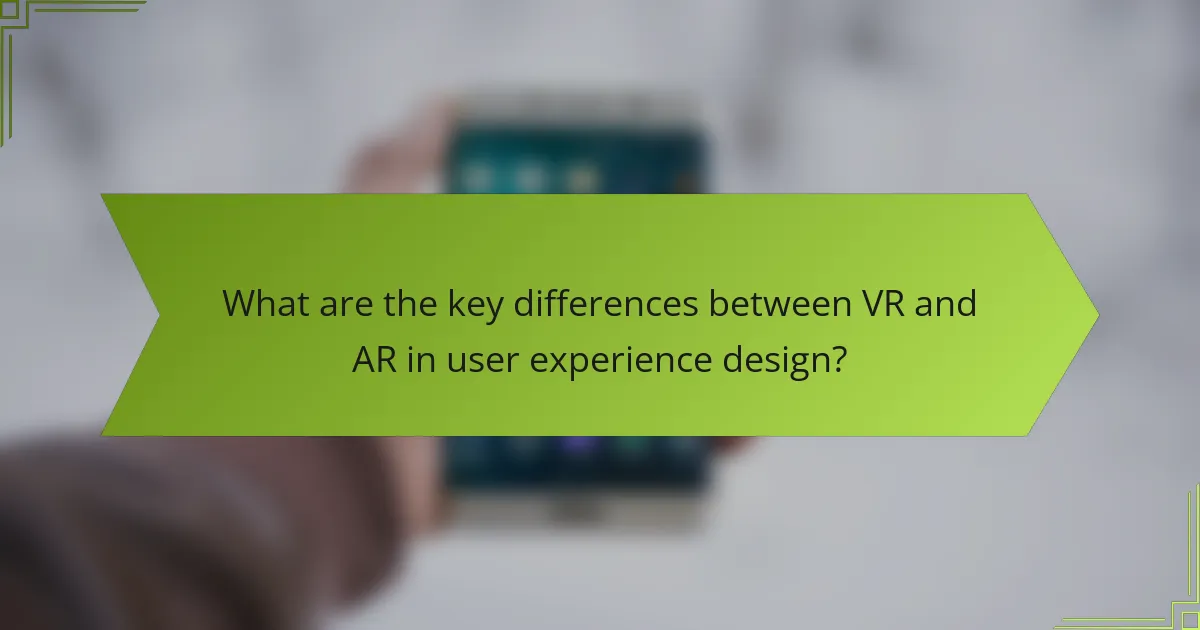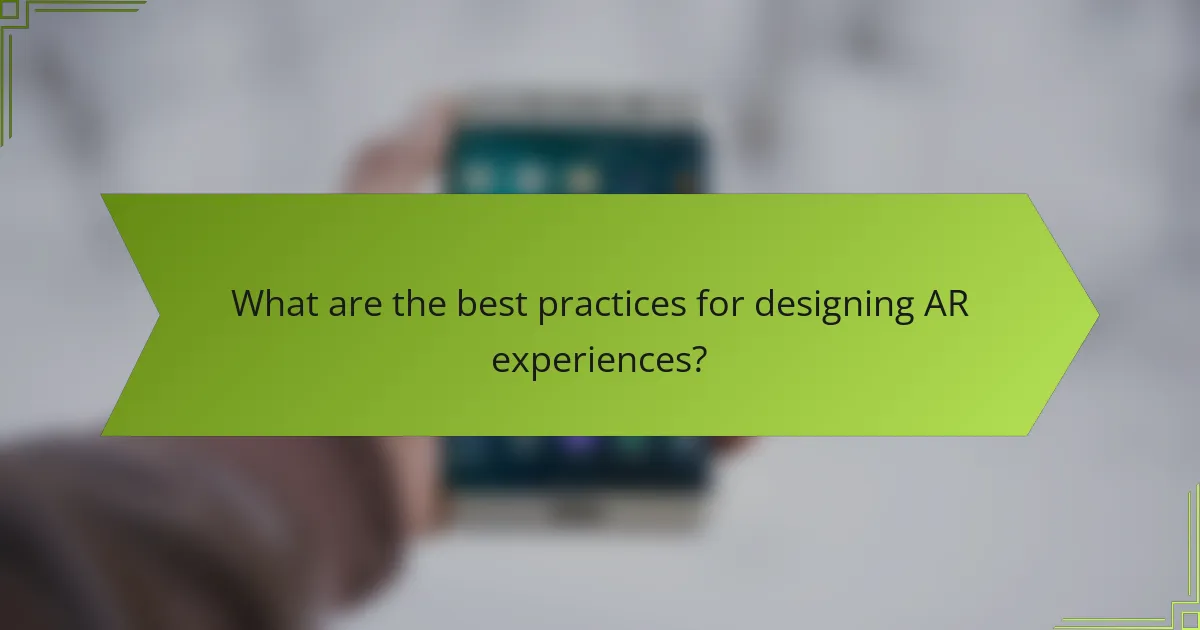When considering user experience design, the choice between Virtual Reality (VR) and Augmented Reality (AR) is crucial, as each offers distinct advantages in user immersion and interaction. VR immerses users in a completely digital environment, while AR enhances the real world with digital overlays. Understanding the specific goals and needs of your audience will guide you in selecting the most suitable approach for your project.

What are the key differences between VR and AR in user experience design?
Virtual Reality (VR) and Augmented Reality (AR) differ significantly in user experience design, primarily in how they immerse users and interact with the environment. VR creates a fully immersive digital environment, while AR overlays digital elements onto the real world, enhancing the user’s perception of their surroundings.
Immersion levels
Immersion levels in VR are typically much higher than in AR. VR completely replaces the user’s real-world environment with a simulated one, leading to a sense of presence that can be very engaging. In contrast, AR maintains the real-world context, providing an overlay of digital information that enhances rather than replaces the user’s surroundings.
This difference means that VR is often used for applications requiring deep engagement, such as gaming or training simulations, while AR is more suited for tasks that benefit from real-world interaction, like navigation or maintenance support.
Interaction methods
Interaction methods in VR usually involve specialized controllers or hand tracking, allowing users to manipulate objects within the virtual space. This can create a more intuitive experience, as users can engage with the environment in a way that feels natural.
In AR, interaction often relies on touchscreens or voice commands, as users engage with digital elements while still being aware of their physical surroundings. This can lead to a more fragmented experience, as users must balance their attention between the real and digital worlds.
Use cases
VR is commonly used in sectors like gaming, education, and healthcare, where immersive experiences can significantly enhance learning and engagement. For example, VR simulations can train medical professionals in a risk-free environment.
AR, on the other hand, is widely applied in retail, maintenance, and education, where it can provide contextual information or enhance product visualization. An example is using AR apps to visualize furniture in a user’s home before purchase.
Hardware requirements
The hardware requirements for VR are generally more demanding than for AR. VR systems often require high-performance computers or dedicated headsets that can handle complex graphics and provide a seamless experience. This can lead to higher costs and the need for more space.
AR can often be accessed through smartphones or tablets, making it more accessible and cost-effective for users. However, advanced AR applications may still require specialized devices, such as smart glasses, to fully utilize their potential.
Development complexity
Developing for VR tends to be more complex due to the need for creating fully immersive environments and ensuring smooth interactions. This often involves more extensive programming and design efforts to achieve a convincing experience.
AR development can be simpler, as it typically involves overlaying digital content onto existing real-world environments. However, challenges still exist, such as ensuring accurate tracking and alignment of digital elements with the physical world, which can complicate the development process.

How to choose between VR and AR for your project?
Choosing between Virtual Reality (VR) and Augmented Reality (AR) for your project depends on your specific goals, audience needs, and available resources. Understanding the unique strengths of each technology will help you make an informed decision that aligns with your project objectives.
Define project goals
Clearly defining your project goals is essential in determining whether VR or AR is the better fit. If your aim is to create immersive experiences that transport users to entirely new environments, VR is likely the best choice. Conversely, if your project focuses on enhancing the real world with digital information, AR would be more suitable.
Consider the user experience you want to deliver. For example, training simulations often benefit from VR’s immersive capabilities, while AR can enhance retail experiences by overlaying product information in real-time.
Assess target audience
Your target audience plays a crucial role in deciding between VR and AR. Understanding their preferences, technical proficiency, and accessibility needs will guide your choice. For instance, if your audience is tech-savvy and eager for immersive experiences, VR may be appealing.
On the other hand, if your audience includes a broader demographic with varying levels of comfort with technology, AR can offer a more accessible entry point, as it often requires only a smartphone or tablet.
Evaluate budget constraints
Budget constraints can significantly influence your decision between VR and AR. Generally, VR projects may require higher initial investments due to the need for specialized hardware and software development. Costs can range from several thousand to tens of thousands of dollars depending on complexity.
AR projects, while still requiring investment, can often be developed at a lower cost, especially if leveraging existing mobile devices. Consider your budget and the return on investment you expect from each approach.
Consider technological capabilities
Assessing the technological capabilities available for your project is vital. VR typically requires robust hardware, such as headsets and powerful computers, which can limit accessibility for some users. Ensure that your audience has the necessary equipment to fully engage with the VR experience.
AR, however, can often be accessed through smartphones or tablets, making it more widely available. Evaluate the technology landscape and choose the approach that aligns with the devices your audience is likely to use.

What are the best practices for designing VR experiences?
Designing effective VR experiences requires a focus on user comfort, intuitive navigation, realistic environments, and robust feedback mechanisms. These elements ensure that users can engage fully and safely with the virtual world.
User comfort and safety
User comfort and safety are paramount in VR design. Prolonged use can lead to discomfort or motion sickness, so it’s essential to minimize rapid movements and provide adjustable settings for users. Consider implementing features like adjustable field of view and the option to take breaks.
Additionally, ensure that users are aware of their physical surroundings to prevent accidents. Incorporating boundary systems that alert users when they approach the edges of their play area can enhance safety.
Intuitive navigation
Intuitive navigation is crucial for a seamless VR experience. Users should be able to move through the virtual environment without confusion. Implementing familiar controls and visual cues can help guide users effectively.
Consider using teleportation or point-and-click movement methods, as these can reduce motion sickness and make navigation feel more natural. Testing navigation schemes with real users can provide valuable insights into what works best.
Realistic environments
Creating realistic environments enhances immersion in VR. Use high-quality graphics and sound to simulate real-world experiences. Pay attention to details such as lighting and textures, which can significantly affect the user’s perception of the virtual space.
Moreover, consider the context of the environment. For instance, a serene landscape may require softer colors and sounds, while an action-packed scene may benefit from dynamic elements and vibrant visuals.
Feedback mechanisms
Effective feedback mechanisms are essential for user engagement in VR. Providing immediate visual or auditory feedback when users interact with objects helps reinforce their actions and enhances the sense of presence. Haptic feedback can also be a powerful tool to simulate touch and further immerse users.
Design feedback to be clear and intuitive. For example, using color changes or sound cues when users successfully complete an action can guide them through the experience and encourage exploration.

What are the best practices for designing AR experiences?
Designing effective augmented reality (AR) experiences involves understanding user context, ensuring seamless integration with the real world, engaging users effectively, and considering accessibility. These best practices help create intuitive and enjoyable interactions that enhance the user’s environment.
Contextual relevance
Contextual relevance is crucial in AR design, as it ensures that the digital content enhances the user’s real-world experience. Designers should consider the user’s environment, activities, and needs when developing AR features. For example, an AR navigation app should provide directions that are relevant to the user’s current location and orientation.
Incorporating local landmarks or cultural references can further increase the relevance of the experience. This approach not only makes the content more engaging but also fosters a deeper connection between the user and their surroundings.
Seamless integration
Seamless integration of AR elements into the physical world is essential for a smooth user experience. This means that virtual objects should appear naturally within the user’s environment, maintaining proper scale, lighting, and perspective. Utilizing advanced tracking technologies can help achieve this level of integration.
Designers should also minimize disruptions by ensuring that AR content does not obstruct critical real-world information. For instance, an AR overlay in a retail setting should enhance product information without overwhelming the shopper.
User engagement strategies
Effective user engagement strategies are vital for keeping users interested in AR experiences. Gamification techniques, such as rewards or challenges, can motivate users to interact more with the content. For example, an AR scavenger hunt can encourage exploration and interaction with various locations.
Additionally, providing users with choices in how they interact with AR content can enhance their engagement. Allowing users to customize their experience or choose different paths can lead to a more personalized and enjoyable interaction.
Accessibility considerations
Accessibility is a key aspect of AR design, ensuring that all users, including those with disabilities, can enjoy the experience. Designers should consider various factors, such as visual impairments, hearing difficulties, and mobility challenges. Implementing features like voice commands, adjustable text sizes, and alternative navigation methods can make AR experiences more inclusive.
Testing AR applications with diverse user groups can help identify potential accessibility issues. By prioritizing inclusivity, designers can create AR experiences that cater to a broader audience, ultimately enhancing user satisfaction and engagement.
